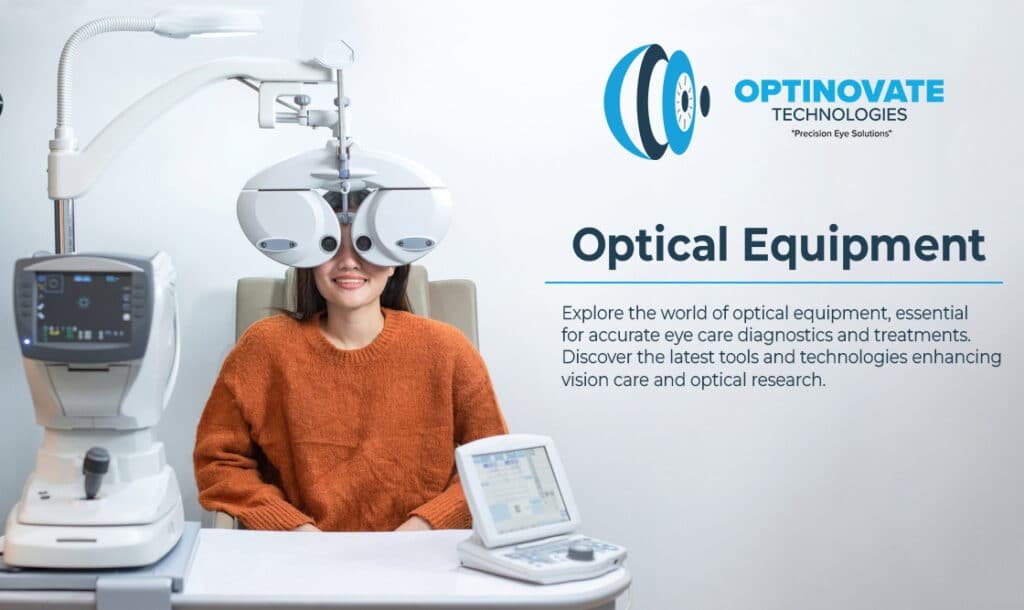Stay updated with the newest innovations and announcements from Optinovate Technologies!
Essential Tools for Precision in Eye Care
Optinovate Technologies
22 May 2024
Optical equipment plays a pivotal role in the diagnosis, treatment, and management of various eye conditions. From routine eye exams to advanced research, the right tools ensure precision and efficiency. This blog delves into the essential optical equipment used by eye care professionals, highlighting their features, uses, and benefits.

Introduction to Optical Equipment
Optical equipment encompasses a wide range of tools and instruments used to examine, diagnose, and treat eye conditions. These devices are integral to providing high-quality eye care, ensuring accurate diagnoses, effective treatments, and optimal patient outcomes.
Diagnostic Tools

Autorefractors are essential for measuring refractive errors in the eyes. These devices use light to measure a patient’s prescription in a precise way.
- Features: Quick and non-invasive, providing immediate results.
- Uses: Initial eye exams, determining baseline refractive errors.
Slit lamps magnify and show a detailed view of the eye’s structures for examination of the front part of the eye.
- Features: Adjustable illumination and magnification.
- Uses: Diagnosing cataracts, corneal injuries, and other anterior eye conditions.
Keratometers
Keratometers, such as the Keratometer TW-2338 with Table, measure the curvature of the cornea. This measurement is crucial for fitting contact lenses and diagnosing conditions like keratoconus.
- Features: High precision, stable table for accurate readings.
- Uses: Contact lens fitting, corneal curvature assessments.
Vision Testing Instruments

Phoropters
Optometrists use phoropters during eye exams to determine a patient’s prescription. You can switch the lenses in the glasses to find the most accurate correction.
- Features: Multiple lens options, precise adjustments.
- Uses: Prescription determination, comprehensive eye exams.
PD Meters
PD meters measure the pupillary distance, which is essential for proper lens placement in eyeglasses.
- Features: Digital and manual options, easy to use.
- Uses: Ensuring accurate eyeglass lens placement.
Surgical Instruments

Lasers
Surgeons use lasers in various eye surgeries, including LASIK and cataract removal. They provide precision and minimal invasiveness, leading to quicker recovery times.
- Features: High precision, controlled energy delivery.
- Uses: Refractive surgery, cataract surgery.
Microkeratomes
Surgeons use microkeratomes in LASIK surgery to create a flap in the cornea. This device is essential for the precision and safety of the procedure.
- Features: Fine blade, adjustable settings.
- Uses: LASIK surgery.
Specialized Equipment
Tonometers
Tonometers measure intraocular pressure (IOP), a crucial factor in diagnosing and managing glaucoma.
- Features: Non-contact and contact options.
- Uses: Glaucoma screening, monitoring IOP.
Retinoscopes
Retinoscopes check for vision problems by shining light into the eye and looking at the reflection on the retina. The device uses light to examine the eyes. It helps detect any issues with vision. The doctor observes the reflection on the retina to determine if there are any problems.
- Features: Portable, easy to use.
- Uses: Initial refractive error assessment, pediatric eye exams.
Conclusion
Optical equipment is the backbone of effective eye care. From diagnostics to treatment, these tools enable eye care professionals to provide accurate, efficient, and high-quality care. Staying updated on new optical tools is crucial for better patient results and encouraging progress in eye health.
Upgrading to advanced optical equipment improves accuracy in healthcare and raises the quality of patient care. If you work in eye care or optical research, it’s important to know and use these essential tools for success.
Related
Discover more from Optinovate Technologies
Subscribe to get the latest posts sent to your email.

